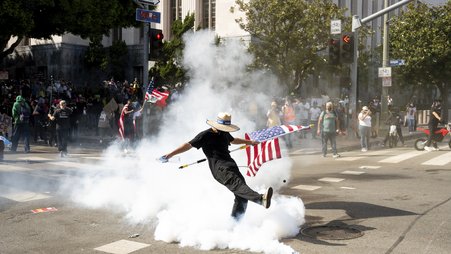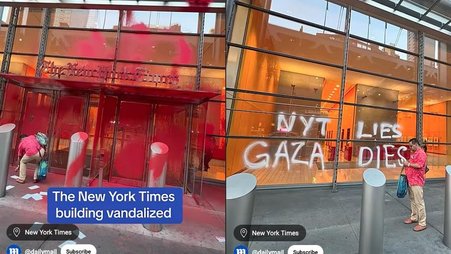Press freedom violations have soared in recent weeks, as a nationwide protest movement over the Israel-Gaza war has spread across college campuses.
The U.S. Press Freedom Tracker has documented dozens of abuses connected to pro-Palestinian protests and counterprotests, and the numbers will likely grow.
These recent incidents confirm what past data in the Tracker has demonstrated: protests are an especially dangerous place for journalists. In particular, arrests and detentions of journalists, physical attacks on reporters by police and protesters, and police blocking journalists’ access to protests have emerged as troubling trends in the latest campus protests.
Arrests or detentions must stop
Joseph Rushmore is one of the many journalists police have arrested for simply doing their jobs covering protests. Texas Department of Public Safety officers violently arrested Rushmore, a freelance photojournalist, while he was photographing a protest at the University of Texas at Austin on April 24, 2024. Officers pushed Rushmore to the ground before using their shields to push and crush him against protesters who had also been pushed along with him. Police charged Rushmore with misdemeanor trespassing, held him overnight, and dropped the charges the next day.
Numerous reporters have been arrested or detained while covering protests over the Israel-Gaza war, including several recently on college campuses.
Some of the charges have been dropped quickly. But even still, the damage is done: Arresting journalists stops them from reporting. For example, police arrested TV journalist Adelmi Ruiz while covering student protests at California State Polytechnic University, Humboldt. Despite complying with police directives, Ruiz was handcuffed, removed from the protest, and taken to the county jail. It wasn’t until hours later, when police dropped the charges, that Ruiz was able to return to campus and resume her reporting.
But charges against other journalists haven’t been dropped as quickly. Two reporters for the student newspaper The Dartmouth, Charlotte Hampton and Alesandra Gonzales, were arrested for criminal trespass while covering a campus protest on May 1, 2024. Public shaming by The Dartmouth and a coalition of press freedom organizations led by the Student Press Law Center may have inspired the Dartmouth president to acknowledge that the student journalists shouldn’t have been arrested. But it took more than a week for prosecutors to drop the charges, which never should have been brought in the first place.
Still other charges against journalists haven’t been dropped at all. KTBC broadcast photographer Carlos Sanchez is facing two misdemeanor charges after he was arrested while covering the same protest where Rushmore was arrested. The Texas Department of Public Safety claims Sanchez intentionally hit officers with his camera, even though video from numerous camera angles shows no such thing.
The case against Sanchez is so weak that the department can’t even make up its mind on what to charge him with. Journalism and press freedom organizations led by the Society of Professional Journalists have condemned these latest charges against Sanchez, but police and prosecutors don’t appear to be listening.
When officials continue to pursue criminal charges against journalists who are simply doing their jobs to document protests, it sends a chilling message to other reporters: Stay away, or we’ll prosecute you, too.
Police must stop arresting journalists covering protests and, if they mistakenly detain a reporter, they should immediately release them and allow them to continue gathering the news.
Physical attacks are a crime
In one of the most shocking incidents documented by the Tracker so far, counterprotesters attacked four student journalists for the Daily Bruin at UCLA in the early morning hours of May 1, 2024. Catherine Hamilton, Shaanth Kodialam, Christopher Buchanan, and a fourth unnamed Bruin reporter were surrounded by counterprotesters and punched, beaten, kicked, or sprayed with chemical irritants. Hamilton was briefly hospitalized following the attack.
That same night, Dolores Quintana, co-editor of the weekly newspaper the Santa Monica Mirror, was also assaulted by counterprotesters. Quintana told the Tracker that she was struck on the back, grabbed, had her phone deliberately knocked from her hand, and was eventually sprayed with a chemical irritant from just inches away.
Physical attacks against journalists are a crime. They also undermine the ability of the press to report the news.
When protesters or counterprotesters purposefully attack the press, it makes it harder to get the news out to the public — which is exactly what some may want. As Quintana wrote, the counterprotesters at UCLA were “deliberately targeting” the press “so that there’s no one there to take pictures and get video of the crimes that they are committing.” Physical attacks also deter others from reporting on protests, for fear that they too will be harmed.
If police weren’t so busy arresting journalists, perhaps they could prioritize investigating attacks on them instead. In a free society, crimes against the press should never be tolerated. Those responsible for the attacks on the press at UCLA and elsewhere must be held accountable.
Blocking access to control the narrative
Police have blocked journalists or confined them to areas where they can’t observe protests or police activity, often as a tactic to stop the press from observing the actions they take against protesters.
For example, the Tracker has documented incident after incident at Columbia University of journalists driven off campus and kettled, confined to campus buildings and threatened with arrest, or blocked from leaving buildings on the night the New York City Police Department cleared Hamilton Hall, which had been occupied by protesters earlier that day.
Apparently, the NYPD didn’t want journalists — or the public — to witness the violent clearing of Hamilton Hall, where the Columbia Spectator reported that police pushed protesters to the ground, slammed them with metal barricades, and threw at least one protester down steps. Later, it came out that one NYPD officer had fired his gun.
Instead, the NYPD wanted the public to see their official police version of events. A day after the raid, the department put out a propaganda video casting protesters as violent, smelly agitators, and the cops as heroes. According to Columbia Journalism School Dean Jelani Cobb, police actually blocked the press from accessing Hamilton Hall at one point because they were filming their sizzle reel.
From Columbia to California, requiring journalists to stay away from the action is a blatant attempt by the police to control their narrative about the protests and the police response. Corralling journalists to designated reporting areas blocks them from viewing events and speaking to sources.
These are just a few of the incidents documented by the Tracker in recent days. More reports of journalists being arrested, attacked by protesters or counterprotesters, targeted with chemical irritants, or having their access to protests restricted keep pouring in.
These continued press freedom violations are a national embarrassment. Police and protesters know that interfering with the press is unacceptable. Police departments nationwide paid millions to settle lawsuits that followed similar abuses during the Black Lives Matter protests in 2020.
But they also seem to believe — often correctly — that they can get away with it. Until prosecutors or the public hold police and others who violate press freedom accountable, journalists covering protests will remain under threat.





